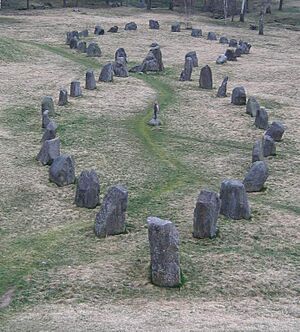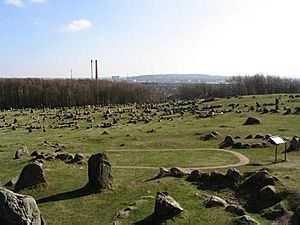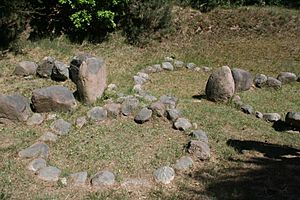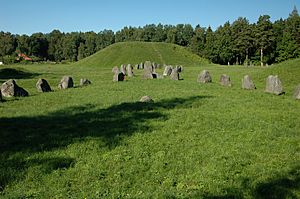Stone ship facts for kids
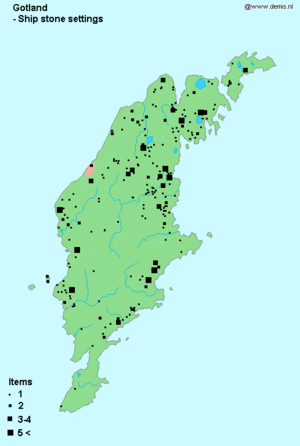
A stone ship or ship setting is an old type of burial site. It was popular in Scandinavia, Northern Germany, and the Baltic states. People would arrange stones in the shape of a ship around a grave or where someone was cremated. These stone ships come in many sizes. They were built from about 1000 BC to 1000 AD.
Contents
What are Stone Ships?
Stone ships are ancient burial places. They are mostly found in Scandinavia. You can also see them in Northern Germany and the Baltic states. The stones are placed tightly or loosely to form the outline of a ship. They are often found in grave fields. Sometimes, they are found alone, far from other old sites.
Sizes and Shapes
Stone ships come in many different sizes. Some are very, very big. The largest known one is the Jelling stone ship in Denmark. Most of it is destroyed now. But it was at least 170 meters (558 feet) long. In Sweden, they can be 67 meters (220 feet) long, like Ale's Stones. Others are only a few meters long.
The way they face can also be different. Inside, they might be paved with stones. Or they might be filled with stones. Some even have taller stones where masts would be on a real ship. Larger stones at the ends often make them look even more like ships. Some have a slanted back end.
Where and When They Were Built
You can find scattered examples in Northern Germany. They are also along the coast of the Baltic States. Digging up these sites shows when they were built. Many are from the later part of the Nordic Bronze Age. This was around 1000 BC to 500 BC. Examples are found on Gotland. Others are from the Germanic Iron Age, the Vendel Period, and the Viking Age. You can see these in Blekinge and Scania.
Why Were They Built?
Experts have different ideas about why stone ships were built. Some think they were meant to give the dead everything they had in life. Others believe they were specifically for the journey to the afterlife, like Hel. It's a bit of a mystery. Sometimes, they are found at the bottom of a burial mound. They enclose a flat area. This area was probably used for public ceremonies.
Some scholars also connect stone ships to old myths. They suggest a link to the goddess Freyja. Her afterlife homes, Fólkvangr and Sessrúmnir, together create an image of a 'ship in a field'. This idea of a "ship in the field" might have been a reflection of how people buried their dead. It could also be that the symbolic ship was thought to bring good things to the land. This could include good seasons and peace.
Famous Stone Ships
Denmark
- Bække: North of Bække, there is a 45-meter (148-foot) long ship. It dates back to the Viking Age.
- Jelling stone ship: Under the southern mound in Jelling, Denmark, a huge Viking Age stone ship was found. It is the largest known. It was either 170 meters (558 feet) or 354 meters (1,161 feet) long.
- Kerteminde fjord: A 20-meter (66-foot) long ship from the Viking Age.
- Lejre: This ship is about 80 meters (262 feet) long and has 28 stones. It was almost destroyed in 1921. But local people saved the stones. It is from the Viking Age.
- Lindholm Høje: Near Aalborg, Denmark. This place has the most well-preserved stone ships.
Germany
- Altes Lager (Menzlin): Near Anklam, Western Pomerania, Germany. These stone ships are from the 9th century.
Sweden
- Ale's Stones: A stone ship in southern Sweden. It is 67 meters (220 feet) long and 19 meters (62 feet) wide.
- Anundshög: This site has a double stone ship. It is 100 meters (328 feet) long. One of the ships is 25 meters (82 feet) wide. There are also several smaller stone ships nearby.
- Askeberga: Sweden's second largest stone ship. It is 55 meters (180 feet) long. It is special because it is made of 24 huge boulders. Each one weighs about 25 tonnes.
- Blomsholm stone ships: The stone ship at Blomsholm is near Strömstad. It is over 40 meters (131 feet) long. It has 49 large menhirs (tall standing stones). The front and back are about 4 meters (13 feet) high. There are other large stone structures in the area.
- Gettlinge grave field: Located on Öland, Sweden.
- Hulterstad grave field: Also on Öland, Sweden. It has 170 burial places in total.
- Tjelvar's Grave: In Boge. Legend says it is the grave of Gotland's mythical discoverer, Thjelvar. It is dated to about 750 BC.
Latvia
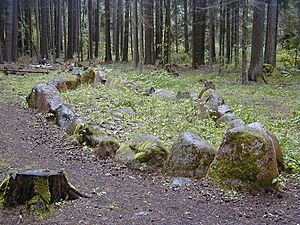
- "Velna laivas" (Devils' ships): These are mainly found in Talsu novads (northern Courland). They are dated to about 950–750 BC.
See also
 In Spanish: Barco de piedra para niños
In Spanish: Barco de piedra para niños


